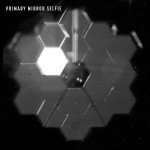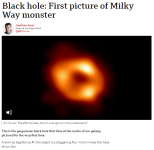Sunshield is fully deployed (five layers) and tensioned - a really big accomplishment.
OT James Webb Space Telescope Updates
- Thread starter PSU73
- Start date
You are using an out of date browser. It may not display this or other websites correctly.
You should upgrade or use an alternative browser.
You should upgrade or use an alternative browser.
Phenomenal accomplishment. I am in awe of what the engineering team was able to do on Webb.Sunshield is fully deployed (five layers) and tensioned - a really big accomplishment.
Here's a flight tracker for the Webb.
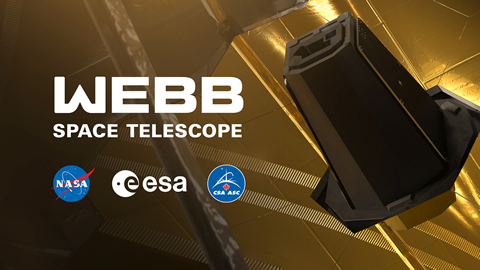

Where Is Webb? NASA/Webb
During Webb's launch, deployment and commissioning, 'WhereIsWebb' tracked Webb's 'flight' to L2 orbit, its state and progress during its deployment and commissioning process, and finally the release of its first images. This process is now complete. During this process, the page constantly...
www.jwst.nasa.gov
Not really. Click on the link above your post to understand the timeline.Webb is now 100% fully deployed!! Incredible.
The one that saysNot really. Click on the link above your post to understand the timeline.
WEBB IS FULLY DEPLOYED! ?
The one that says
WEBB IS FULLY DEPLOYED! ?
I could see reasonable people disagreeing on the interpretation of this:
Webb will continue to travel to the second Lagrange point (L2) for another two weeks, at which point it will enter a large orbit around the L2 point. The following five months will be used to cool the telescope to operating temperature, fine-tune the mirror alignment, and calibrate the instruments.
---

A couple days away from reaching L2 insertion, but several months before the mirrors are aligned.
Here's the latest update so you don't have to chase the link, but it's included as well.
----------------------
Mirror Segment Deployments COMPLETED
Nominal Event Time: Launch + 28 days
Status: Completed
This completes the multi-day multi-step activity to activate and move each of the 18 primary mirror segments and the secondary mirror out of their launch configuration.
The primary mirror segments were driven 12.5 millimeters away from the telescope structure. Using six motors that deploy each segment approximately half the length of a paper clip, these actuators clear the mirrors from their launch restraints and give each segment enough space to later be adjusted in other directions to the optical starting position for the upcoming wavefront alignment process. The 18 radius of curvature (ROC) actuators were moved from their launch position as well. The ROC actuators individually shape the curvature of each beryllium mirror segment to set the initial parabolic shape of the primary mirror.
Next up in the wavefront process will be moving mirrors in the micron and nanometer ranges to reach the final optical positions for an aligned telescope. The process of telescope alignment will take approximately three months.
------------------------
Where Is Webb? NASA/Webb
Here's the latest update so you don't have to chase the link, but it's included as well.
----------------------
Mirror Segment Deployments COMPLETED
Nominal Event Time: Launch + 28 days
Status: Completed
This completes the multi-day multi-step activity to activate and move each of the 18 primary mirror segments and the secondary mirror out of their launch configuration.
The primary mirror segments were driven 12.5 millimeters away from the telescope structure. Using six motors that deploy each segment approximately half the length of a paper clip, these actuators clear the mirrors from their launch restraints and give each segment enough space to later be adjusted in other directions to the optical starting position for the upcoming wavefront alignment process. The 18 radius of curvature (ROC) actuators were moved from their launch position as well. The ROC actuators individually shape the curvature of each beryllium mirror segment to set the initial parabolic shape of the primary mirror.
Next up in the wavefront process will be moving mirrors in the micron and nanometer ranges to reach the final optical positions for an aligned telescope. The process of telescope alignment will take approximately three months.
------------------------
Where Is Webb? NASA/Webb
It also has a long way to go to reach the -233C operating temperature.A couple days away from reaching L2 insertion, but several months before the mirrors are aligned.
Here's the latest update so you don't have to chase the link, but it's included as well.
----------------------
Mirror Segment Deployments COMPLETED
Nominal Event Time: Launch + 28 days
Status: Completed
This completes the multi-day multi-step activity to activate and move each of the 18 primary mirror segments and the secondary mirror out of their launch configuration.
The primary mirror segments were driven 12.5 millimeters away from the telescope structure. Using six motors that deploy each segment approximately half the length of a paper clip, these actuators clear the mirrors from their launch restraints and give each segment enough space to later be adjusted in other directions to the optical starting position for the upcoming wavefront alignment process. The 18 radius of curvature (ROC) actuators were moved from their launch position as well. The ROC actuators individually shape the curvature of each beryllium mirror segment to set the initial parabolic shape of the primary mirror.
Next up in the wavefront process will be moving mirrors in the micron and nanometer ranges to reach the final optical positions for an aligned telescope. The process of telescope alignment will take approximately three months.
------------------------
Where Is Webb? NASA/Webb
Nasa has released initial photos from the telescope as they bring it online.




It's at -210C now; is it difficult to drop it further?It also has a long way to go to reach the -233C operating temperature.
James Webb Telescope, as of about 3:00 PM, is now in the L2 orbital position. Still months away from from operating but another success.
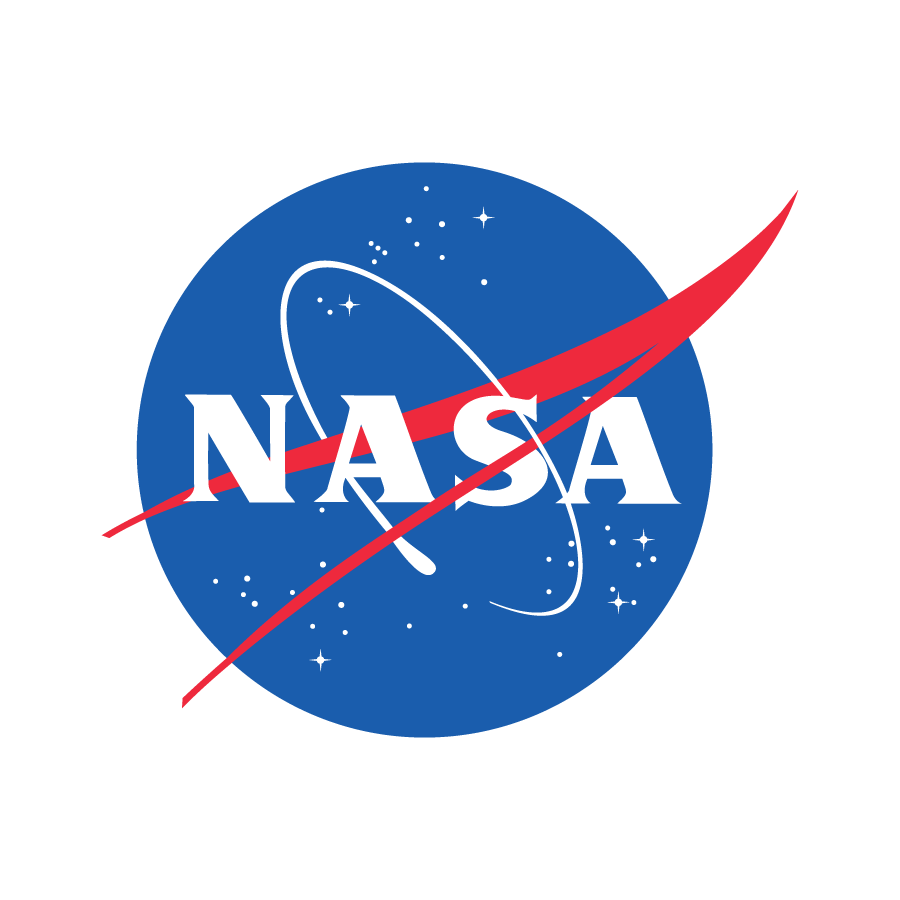
 blogs.nasa.gov
blogs.nasa.gov

James Webb Space Telescope Archives - NASA Science
JWT is months away from anything new, but the website has a new feature that I just saw today. It's a 3D look around the universe. I can't quite figure out where I am sitting with it. Might be worth a 'giggle' for enthusiasts while we wait for the good stuff. I found it interesting to see where Voyager 1 is, Haley's Comet, Hale-Bopp, etc. Scroll down when you go to the page. You can use your mouse to move the perspective 360. Here's a pic as an example:
Where Is Webb? NASA/Webb
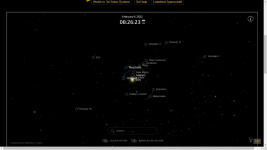
Where Is Webb? NASA/Webb

Good news for the JWT team. They turned the telescope mirrors to a specific star and found it 18 times. That is, once on each mirror. They were also able to identify each image to each mirror, raising confidence that all is well and aiding in the alignment of all mirrors as one.
Photons Received: Webb Sees Its First Star – 18 Times - YouTube
Photons Received: Webb Sees Its First Star – 18 Times - YouTube
BBC News -- 'Fully focused' Webb telescope beats expectations
The American space agency has achieved a major milestone in its preparation of the new James Webb Space Telescope.
Engineers say they have now managed to fully focus the $10bn observatory on a test star. The pin-sharp performance is even better than hoped, they add.
To get to this stage, all of Webb's mirrors had to be aligned to tiny fractions of the width of a human hair.
But the agency cautions that a lot of work still lies ahead before the telescope can be declared operational.
Lee Feinberg, the Nasa engineer who has led the development of Webb's optical elements, described the release of the first properly focused image as phenomenal.
"You not only see the star and the spikes from the diffraction of the star, but you see other stars in the field that are tightly focused, just like we expect, and all sorts of other interesting structure in the background," he told reporters.
"We've actually done very detailed analysis of the images we're getting, and, so far, what we're finding is that the performance is as good if not better than our most optimistic prediction."
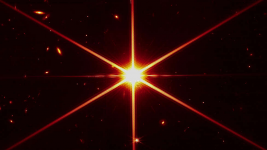
The American space agency has achieved a major milestone in its preparation of the new James Webb Space Telescope.
Engineers say they have now managed to fully focus the $10bn observatory on a test star. The pin-sharp performance is even better than hoped, they add.
To get to this stage, all of Webb's mirrors had to be aligned to tiny fractions of the width of a human hair.
But the agency cautions that a lot of work still lies ahead before the telescope can be declared operational.
Lee Feinberg, the Nasa engineer who has led the development of Webb's optical elements, described the release of the first properly focused image as phenomenal.
"You not only see the star and the spikes from the diffraction of the star, but you see other stars in the field that are tightly focused, just like we expect, and all sorts of other interesting structure in the background," he told reporters.
"We've actually done very detailed analysis of the images we're getting, and, so far, what we're finding is that the performance is as good if not better than our most optimistic prediction."

BBC News -- 'Fully focused' Webb telescope beats expectations
The American space agency has achieved a major milestone in its preparation of the new James Webb Space Telescope.
Engineers say they have now managed to fully focus the $10bn observatory on a test star. The pin-sharp performance is even better than hoped, they add.
To get to this stage, all of Webb's mirrors had to be aligned to tiny fractions of the width of a human hair.
But the agency cautions that a lot of work still lies ahead before the telescope can be declared operational.
Lee Feinberg, the Nasa engineer who has led the development of Webb's optical elements, described the release of the first properly focused image as phenomenal.
"You not only see the star and the spikes from the diffraction of the star, but you see other stars in the field that are tightly focused, just like we expect, and all sorts of other interesting structure in the background," he told reporters.
"We've actually done very detailed analysis of the images we're getting, and, so far, what we're finding is that the performance is as good if not better than our most optimistic prediction."
View attachment 187297
This is not about James Webb though JW may be able to get even better pics. This is the first time photographed black hole at the center of our galaxy.
Here's the pic:
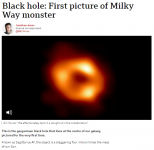
-----------------
The explanation:
This is the gargantuan black hole that lives at the centre of our galaxy, pictured for the very first time.
Known as Sagittarius A*, the object is a staggering four million times the mass of our Sun.
What you see is a central dark region where the hole resides, circled by the light coming from super-heated gas accelerated by immense gravitational forces.
For scale, the ring is roughly the size of Mercury's orbit around our star.
That's about 60 million km, or 40 million miles, across.
Fortunately, this monster is a long, long way away - some 26,000 light-years in the distance - so there's no possibility of us ever coming to any danger.
The image was produced by an international team called the Event Horizon Telescope (EHT) collaboration.
-------------------
And, where we are in relation to it:
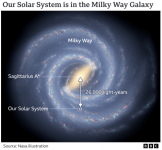
---------------------------
MY QUESTION TO THE AKB:
Is there any reason to be worried, long term of course, that all the spirals of mass around that black hole seem to 'originate' at the center of that spiral,
or is it perhaps that they 'terminate' there? Kinda like the water swirl when you flush a toilet. Asking for a friend.
Here's the pic:

-----------------
The explanation:
This is the gargantuan black hole that lives at the centre of our galaxy, pictured for the very first time.
Known as Sagittarius A*, the object is a staggering four million times the mass of our Sun.
What you see is a central dark region where the hole resides, circled by the light coming from super-heated gas accelerated by immense gravitational forces.
For scale, the ring is roughly the size of Mercury's orbit around our star.
That's about 60 million km, or 40 million miles, across.
Fortunately, this monster is a long, long way away - some 26,000 light-years in the distance - so there's no possibility of us ever coming to any danger.
The image was produced by an international team called the Event Horizon Telescope (EHT) collaboration.
-------------------
And, where we are in relation to it:

---------------------------
MY QUESTION TO THE AKB:
Is there any reason to be worried, long term of course, that all the spirals of mass around that black hole seem to 'originate' at the center of that spiral,
or is it perhaps that they 'terminate' there? Kinda like the water swirl when you flush a toilet. Asking for a friend.
Attachments
This is not about James Webb though JW may be able to get even better pics. This is the first time photographed black hole at the center of our galaxy.
Here's the pic:
View attachment 196445
-----------------
The explanation:
This is the gargantuan black hole that lives at the centre of our galaxy, pictured for the very first time.
Known as Sagittarius A*, the object is a staggering four million times the mass of our Sun.
What you see is a central dark region where the hole resides, circled by the light coming from super-heated gas accelerated by immense gravitational forces.
For scale, the ring is roughly the size of Mercury's orbit around our star.
That's about 60 million km, or 40 million miles, across.
Fortunately, this monster is a long, long way away - some 26,000 light-years in the distance - so there's no possibility of us ever coming to any danger.
The image was produced by an international team called the Event Horizon Telescope (EHT) collaboration.
-------------------
And, where we are in relation to it:
View attachment 196446
---------------------------
MY QUESTION TO THE AKB:
Is there any reason to be worried, long term of course, that all the spirals of mass around that black hole seem to 'originate' at the center of that spiral,
or is it perhaps that they 'terminate' there? Kinda like the water swirl when you flush a toilet. Asking for a friend.
It's just gravity.
It's just a massunderstanding.It's just gravity.
Not James Webb related, but Vger...specifically Vger 1, which was launched 44 years ago (1977) and is presently at the outskirts of our solar system.
I've posted the article but there's more if you go to the link. Here goes:
Link: Voyager is sending ‘impossible data’ back to Nasa from the edge of the Solar System (msn.com)
Article:
Nasa’s engineering team is investigating a mystery taking place on the Voyager 1 spacecraft.
Voyager 1 is the most distant human-made object in existence, having launched 44 years ago. It is currently operating at the edge of the solar system, flying through the interstellar medium beyond the Sun’s influence.
However, scientists found that the craft is receiving and executing commands from Earth successfully but the readouts from the probe’s attitude articulation and control system (AACS) do not reflect what is actually happening on board Voyager 1.
The system maintains the craft’s orientation, keeping its antenna pointed precisely to the Earth so that data can be sent from it to Nasa. While all indications suggest that the AACS is working as normal, the telemetry data it is returning appears to be randomly generated failing to reflect any possible state that the system could be in.
Further, the issue has not triggered any fault protection system that could put Voyager into safe mode, and the signal has not weakened suggesting that the antenna is still in its normal position, pointing towards Earth.
Nasa says that it will continue to monitor the situation, as it is possible that the invalid data could be being produced by another system, but says that it does not understand why it is happening or how long this issue could continue. It takes approximately two days for a message from Earth to reach Voyager and get a response from the craft.
A mystery like this is sort of par for the course at this stage of the Voyager mission, said Suzanne Dodd, project manager for Voyager 1 and 2 at Nasa’s Jet Propulsion Laboratory in Southern California.
The spacecraft are both almost 45 years old, which is far beyond what the mission planners anticipated. We’re also in interstellar space a high-radiation environment that no spacecraft have flown in before. So there are some big challenges for the engineering team. But I think if there’s a way to solve this issue with the AACS, our team will find it.
There is a possibility that Nasa will not find the source of the issue and instead have to issue software changes or use one of the craft’s backup systems something that has been done before in 2017 when Voyager had to switch from its primary thrusters to secondary ones because of signs of degradation.
I've posted the article but there's more if you go to the link. Here goes:
Link: Voyager is sending ‘impossible data’ back to Nasa from the edge of the Solar System (msn.com)
Article:
Nasa’s engineering team is investigating a mystery taking place on the Voyager 1 spacecraft.
Voyager 1 is the most distant human-made object in existence, having launched 44 years ago. It is currently operating at the edge of the solar system, flying through the interstellar medium beyond the Sun’s influence.
However, scientists found that the craft is receiving and executing commands from Earth successfully but the readouts from the probe’s attitude articulation and control system (AACS) do not reflect what is actually happening on board Voyager 1.
The system maintains the craft’s orientation, keeping its antenna pointed precisely to the Earth so that data can be sent from it to Nasa. While all indications suggest that the AACS is working as normal, the telemetry data it is returning appears to be randomly generated failing to reflect any possible state that the system could be in.
Further, the issue has not triggered any fault protection system that could put Voyager into safe mode, and the signal has not weakened suggesting that the antenna is still in its normal position, pointing towards Earth.
Nasa says that it will continue to monitor the situation, as it is possible that the invalid data could be being produced by another system, but says that it does not understand why it is happening or how long this issue could continue. It takes approximately two days for a message from Earth to reach Voyager and get a response from the craft.
A mystery like this is sort of par for the course at this stage of the Voyager mission, said Suzanne Dodd, project manager for Voyager 1 and 2 at Nasa’s Jet Propulsion Laboratory in Southern California.
The spacecraft are both almost 45 years old, which is far beyond what the mission planners anticipated. We’re also in interstellar space a high-radiation environment that no spacecraft have flown in before. So there are some big challenges for the engineering team. But I think if there’s a way to solve this issue with the AACS, our team will find it.
There is a possibility that Nasa will not find the source of the issue and instead have to issue software changes or use one of the craft’s backup systems something that has been done before in 2017 when Voyager had to switch from its primary thrusters to secondary ones because of signs of degradation.
We’re talking pre-Commodore 64 and pre-TRS80 launch date. Amazing on so many levels. So cool it keeps returning data regardless of whether it knows which way is up.Not James Webb related, but Vger...specifically Vger 1, which was launched 44 years ago (1977) and is presently at the outskirts of our solar system.
I've posted the article but there's more if you go to the link. Here goes:
Link: Voyager is sending ‘impossible data’ back to Nasa from the edge of the Solar System (msn.com)
Article:
Nasa’s engineering team is investigating a mystery taking place on the Voyager 1 spacecraft.
Voyager 1 is the most distant human-made object in existence, having launched 44 years ago. It is currently operating at the edge of the solar system, flying through the interstellar medium beyond the Sun’s influence.
However, scientists found that the craft is receiving and executing commands from Earth successfully but the readouts from the probe’s attitude articulation and control system (AACS) do not reflect what is actually happening on board Voyager 1.
The system maintains the craft’s orientation, keeping its antenna pointed precisely to the Earth so that data can be sent from it to Nasa. While all indications suggest that the AACS is working as normal, the telemetry data it is returning appears to be randomly generated failing to reflect any possible state that the system could be in.
Further, the issue has not triggered any fault protection system that could put Voyager into safe mode, and the signal has not weakened suggesting that the antenna is still in its normal position, pointing towards Earth.
Nasa says that it will continue to monitor the situation, as it is possible that the invalid data could be being produced by another system, but says that it does not understand why it is happening or how long this issue could continue. It takes approximately two days for a message from Earth to reach Voyager and get a response from the craft.
A mystery like this is sort of par for the course at this stage of the Voyager mission, said Suzanne Dodd, project manager for Voyager 1 and 2 at Nasa’s Jet Propulsion Laboratory in Southern California.
The spacecraft are both almost 45 years old, which is far beyond what the mission planners anticipated. We’re also in interstellar space a high-radiation environment that no spacecraft have flown in before. So there are some big challenges for the engineering team. But I think if there’s a way to solve this issue with the AACS, our team will find it.
There is a possibility that Nasa will not find the source of the issue and instead have to issue software changes or use one of the craft’s backup systems something that has been done before in 2017 when Voyager had to switch from its primary thrusters to secondary ones because of signs of degradation.
Last edited:
We’re talking pre-Commodore 64 and pre-TRS80 launxh date. Amazing on so many levels. So cool it keeps returning data regardless of whether it knows which way is up.
Pong design era technology with a nuclear powered battery.
Pong? Is that cool new game people are playing? How do they DO that?Pong design era technology with a nuclear powered battery.
Pong? Is that cool new game people are playing? How do they DO that?

I remember the family getting this as a Christmas gift from Santa. I have it and it still works, although I think it needs a few new capacitors as the video signal has gotten pretty weak. It wouldn't be hard to do, but at the same time I can't decide if I want to modify, even to fix, such a vintage item.
So you're saying the system is being manipulated by aliens, right?Not James Webb related, but Vger...specifically Vger 1, which was launched 44 years ago (1977) and is presently at the outskirts of our solar system.
I've posted the article but there's more if you go to the link. Here goes:
Link: Voyager is sending ‘impossible data’ back to Nasa from the edge of the Solar System (msn.com)
Article:
Nasa’s engineering team is investigating a mystery taking place on the Voyager 1 spacecraft.
Voyager 1 is the most distant human-made object in existence, having launched 44 years ago. It is currently operating at the edge of the solar system, flying through the interstellar medium beyond the Sun’s influence.
However, scientists found that the craft is receiving and executing commands from Earth successfully but the readouts from the probe’s attitude articulation and control system (AACS) do not reflect what is actually happening on board Voyager 1.
The system maintains the craft’s orientation, keeping its antenna pointed precisely to the Earth so that data can be sent from it to Nasa. While all indications suggest that the AACS is working as normal, the telemetry data it is returning appears to be randomly generated failing to reflect any possible state that the system could be in.
Further, the issue has not triggered any fault protection system that could put Voyager into safe mode, and the signal has not weakened suggesting that the antenna is still in its normal position, pointing towards Earth.
Nasa says that it will continue to monitor the situation, as it is possible that the invalid data could be being produced by another system, but says that it does not understand why it is happening or how long this issue could continue. It takes approximately two days for a message from Earth to reach Voyager and get a response from the craft.
A mystery like this is sort of par for the course at this stage of the Voyager mission, said Suzanne Dodd, project manager for Voyager 1 and 2 at Nasa’s Jet Propulsion Laboratory in Southern California.
The spacecraft are both almost 45 years old, which is far beyond what the mission planners anticipated. We’re also in interstellar space a high-radiation environment that no spacecraft have flown in before. So there are some big challenges for the engineering team. But I think if there’s a way to solve this issue with the AACS, our team will find it.
There is a possibility that Nasa will not find the source of the issue and instead have to issue software changes or use one of the craft’s backup systems something that has been done before in 2017 when Voyager had to switch from its primary thrusters to secondary ones because of signs of degradation.
Well, to some degree. I can't really explain it in a scientific way. It's evidence they are using worm holes. Whether they are 'manipulating' it to hide the worm holes or not I couldn't guess. All those alien sightings, especially the 'fleet' of alien ship sightings, are for the most part cargo vehicles. They are vacuuming our atmosphere, super compressing it, and transporting it back to their failing planet using the worm holes, in hopes of saving their planet.So you're saying the system is being manipulated by aliens, right?
I'll see if I can learn more if I get abducted again.
Last edited:
don't let them do anything sexualWell, to some degree. I can't really explain it in a scientific way. It's evidence they are using worm holes. Whether they are 'manipulating' it to hide the worm holes or not I couldn't guess. All those alien sightings, especially the 'fleet' of alien ship sightings, are for the most part cargo vehicles. They are vacuuming our atmosphere, super compressing it, and transporting it back to their failing planet using the worm holes, in hopes of saving their planet.
I'll see if I can learn more if I get abducted again.
What happens on the other side of the worm hole …don't let them do anything sexual
Why not?? I'm sure the experience would be out of this world.don't let them do anything sexual
A bit more info on what to expect beginning July 12
------------------------------------------------------------
First Images From NASA’s Webb Space Telescope Coming Soon
NASA’s James Webb Space Telescope, a partnership with ESA (European Space Agency) and the Canadian Space Agency (CSA), will release its first full-color images and spectroscopic data on July 12, 2022. As the largest and most complex observatory ever launched into space, Webb has been going through a six-month period of preparation before it can begin science work, calibrating its instruments to its space environment and aligning its mirrors. This careful process, not to mention years of new technology development and mission planning, has built up to the first images and data: a demonstration of Webb at its full power, ready to begin its science mission and unfold the infrared universe.
“As we near the end of preparing the observatory for science, we are on the precipice of an incredibly exciting period of discovery about our universe. The release of Webb’s first full-color images will offer a unique moment for us all to stop and marvel at a view humanity has never seen before,” said Eric Smith, Webb program scientist at NASA Headquarters in Washington. “These images will be the culmination of decades of dedication, talent, and dreams – but they will also be just the beginning.”
Behind the Scenes: Creating Webb’s First Images
Deciding what Webb should look at first has been a project more than five years in the making, undertaken by an international partnership between NASA, ESA, CSA, and the Space Telescope Science Institute (STScI) in Baltimore, home to Webb’s science and mission operations.
“Our goals for Webb’s first images and data are both to showcase the telescope’s powerful instruments and to preview the science mission to come,” said astronomer Klaus Pontoppidan, Webb project scientist at STScI. “They are sure to deliver a long-awaited ‘wow’ for astronomers and the public.”
Once each of Webb’s instruments has been calibrated, tested, and given the green light by its science and engineering teams, the first images and spectroscopic observations will be made. The team will proceed through a list of targets that have been preselected and prioritized by an international committee to exercise Webb’s powerful capabilities. Then the production team will receive the data from Webb’s instrument scientists and process it into images for astronomers and the public.
“I feel very privileged to be a part of it,” said Alyssa Pagan, a science visuals developer at STScI. “Typically, the process from raw telescope data to final, clean image that communicates scientific information about the universe can take anywhere from weeks to a month,” Pagan said.
What Will We See?
While careful planning for Webb’s first full-color images has been underway for a long time, the new telescope is so powerful that it is difficult to predict exactly how the first images will look. “Of course, there are things we are expecting and hoping to see, but with a new telescope and this new high-resolution infrared data, we just won’t know until we see it,” said STScI’s lead science visuals developer Joseph DePasquale.
Early alignment imagery has already demonstrated the unprecedented sharpness of Webb’s infrared view. However, these new images will be the first in full color and the first to showcase Webb’s full science capabilities. In addition to imagery, Webb will be capturing spectroscopic data – detailed information astronomers can read in light. The first images package of materials will highlight the science themes** that inspired the mission and will be the focus of its work: the early universe, the evolution of galaxies through time, the lifecycle of stars, and other worlds. All of Webb’s commissioning data – the data taken while aligning the telescope and preparing the instruments – will also be made publicly available.
** Science Themes - Webb/NASA
Where Is Webb? NASA/Webb - Website
------------------------------------------------------------
First Images From NASA’s Webb Space Telescope Coming Soon
NASA’s James Webb Space Telescope, a partnership with ESA (European Space Agency) and the Canadian Space Agency (CSA), will release its first full-color images and spectroscopic data on July 12, 2022. As the largest and most complex observatory ever launched into space, Webb has been going through a six-month period of preparation before it can begin science work, calibrating its instruments to its space environment and aligning its mirrors. This careful process, not to mention years of new technology development and mission planning, has built up to the first images and data: a demonstration of Webb at its full power, ready to begin its science mission and unfold the infrared universe.
“As we near the end of preparing the observatory for science, we are on the precipice of an incredibly exciting period of discovery about our universe. The release of Webb’s first full-color images will offer a unique moment for us all to stop and marvel at a view humanity has never seen before,” said Eric Smith, Webb program scientist at NASA Headquarters in Washington. “These images will be the culmination of decades of dedication, talent, and dreams – but they will also be just the beginning.”
Behind the Scenes: Creating Webb’s First Images
Deciding what Webb should look at first has been a project more than five years in the making, undertaken by an international partnership between NASA, ESA, CSA, and the Space Telescope Science Institute (STScI) in Baltimore, home to Webb’s science and mission operations.
“Our goals for Webb’s first images and data are both to showcase the telescope’s powerful instruments and to preview the science mission to come,” said astronomer Klaus Pontoppidan, Webb project scientist at STScI. “They are sure to deliver a long-awaited ‘wow’ for astronomers and the public.”
Once each of Webb’s instruments has been calibrated, tested, and given the green light by its science and engineering teams, the first images and spectroscopic observations will be made. The team will proceed through a list of targets that have been preselected and prioritized by an international committee to exercise Webb’s powerful capabilities. Then the production team will receive the data from Webb’s instrument scientists and process it into images for astronomers and the public.
“I feel very privileged to be a part of it,” said Alyssa Pagan, a science visuals developer at STScI. “Typically, the process from raw telescope data to final, clean image that communicates scientific information about the universe can take anywhere from weeks to a month,” Pagan said.
What Will We See?
While careful planning for Webb’s first full-color images has been underway for a long time, the new telescope is so powerful that it is difficult to predict exactly how the first images will look. “Of course, there are things we are expecting and hoping to see, but with a new telescope and this new high-resolution infrared data, we just won’t know until we see it,” said STScI’s lead science visuals developer Joseph DePasquale.
Early alignment imagery has already demonstrated the unprecedented sharpness of Webb’s infrared view. However, these new images will be the first in full color and the first to showcase Webb’s full science capabilities. In addition to imagery, Webb will be capturing spectroscopic data – detailed information astronomers can read in light. The first images package of materials will highlight the science themes** that inspired the mission and will be the focus of its work: the early universe, the evolution of galaxies through time, the lifecycle of stars, and other worlds. All of Webb’s commissioning data – the data taken while aligning the telescope and preparing the instruments – will also be made publicly available.
** Science Themes - Webb/NASA
Where Is Webb? NASA/Webb - Website

NASA’s new powerful space telescope gets hit by larger than expected micrometeoroid
One of JWST’s 18 mirrors was struck.
I love these comparison pictures between the Hubble and JWST
First image released today by President Biden: View attachment 210774
A long, long time ago in a bunch of galaxies far, far away . . . .
